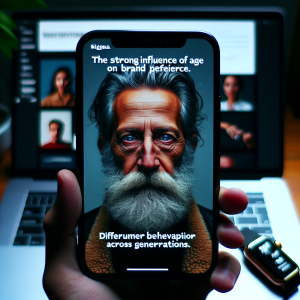Age and Brand Preferences: In-Depth Study of Significant Impacts
In an increasingly developed and diverse market context, understanding the differences in brand preferences by age becomes very important. Age can significantly affect how consumers choose and interact with brands. Therefore, this article will provide a profound analysis of the impact of age on brand preferences and offer useful insights for marketers.
Theoretical Basis for the Impact of Age on Consumer Behavior
The psychology and sociology of consumers often play a large role in shaping brand preferences. Factors such as cultural values, personal experiences, and social development all influence how different generations perceive and favor brands. Notably, previous studies have indicated that the relationship between age and brand preferences is not merely a change in psychology but also intertwined with economic and technological factors.
Age and Brand Preferences: Analysis by Generation
Gen Z and Brands: Authenticity, Values, and Connection
The Gen Z generation, born from the mid-1990s to the early 2010s, often prioritize brands with authentic values and social commitment. They tend to seek emotional connections with brands rather than just products. When brands show sustainable values and social responsibility, they attract strong interest from this age group.
Millennials: Brand Loyalty and Experience Preferences
Millennials, or Generation Y, typically value experiences more than material possessions. They are more likely to remain loyal to a brand if it provides memorable experiences and high-quality customer service. For Millennials, brands are seen as part of their lifestyle, and they often share their experiences through social media.
Gen X: Practical Value and Credible Brands
Gen X, born from the mid-1960s to the early 1980s, often seek quality and practical value from the brands they choose. They tend to be loyal to brands they trust and believe provide practical benefits for their daily lives.
Baby Boomers: Traditional Brands and Quality
Baby Boomers, born from 1946 to 1964, often prioritize well-established and reputable brands. They tend to stick with what they know and trust, so brands need to create a reliable and quality image to attract this age group.
Key Factors Influencing Brand Preferences by Age
Besides the characteristics of each generation, there are many external factors that can influence brand preferences by age:
Influence of Culture and Society
The surrounding culture and society have a significant impact on how each age group perceives and interacts with brands. Cultural trends, regional differences, and major events also affect brand choices.
Impact of Personal Experience
A consumer’s personal experience is an important factor in shaping brand preferences. Memories and both positive and negative experiences with a particular brand will change how consumers perceive that brand in the future.
The Role of Media and Marketing
Media has a strong influence in shaping preferences and shopping behavior. Different media channels can attract the attention of different age groups, from traditional advertising to social media.
Changes in Values and Priorities by Age
Changes in life values, priorities, and needs also affect brand preferences at each age stage. As people mature, take on more responsibilities, or experience life events, their values and priorities also change.
Practical Research: Surveying Brand Preferences of Vietnamese Consumers by Age
To partially validate the theories stated, we conducted a survey study on brand preferences among consumers in Vietnam based on age.
Research Method and Survey Participants
The research was conducted through an online survey with the participation of over 1,000 individuals from various age groups to understand their brand preferences and trends.
Research Results: Comparing Brand Preferences Among Age Groups
The research results indicate a clear difference in brand preferences among age groups. Gen Z prefers brands that demonstrate creativity and authenticity, while Baby Boomers favor traditional and reputable brands.
Statistical Analysis and Assessment of Age’s Impact
Statistical analysis shows that age has a significant effect on brand choice, with a strong correlation coefficient between age and brand loyalty.
Applying Age and Brand Preference Research in Marketing Strategies
The findings from the above research can assist marketers in developing more effective marketing strategies.
Market Segmentation by Age: Personalized Approach
Segmenting the market by age allows brands to create tailored marketing programs, optimizing messaging for each age group.
Building Appropriate Messaging and Communication Channels for Each Generation
Brands need to ensure that their communication messages are appropriate for each generation, thereby creating a deeper connection with consumers.
Optimizing Customer Experience Based on Brand Preferences
Finally, optimizing customer experiences based on brand preferences is key to creating satisfaction and loyalty from customers.
Conclusion: The Importance of Understanding Brand Preferences by Age
In conclusion, understanding the impact of age on brand preferences is crucial for any marketing strategy. Capturing the differences in brand preferences by age will help brands not only enhance communication effectiveness but also optimize customer experiences. We hope this article has provided useful information and fresh perspectives for readers.
Contact us today for tailored consultation!
Intage Vietnam: Your trusted partner for comprehensive and effective market research solutions.
📞 (+8428) 3820 5558
🌐 https://intage.com.vn/
🏢 45 Vo Thi Sau, Da Kao Ward, District 1, Ho Chi Minh City, Vietnam





